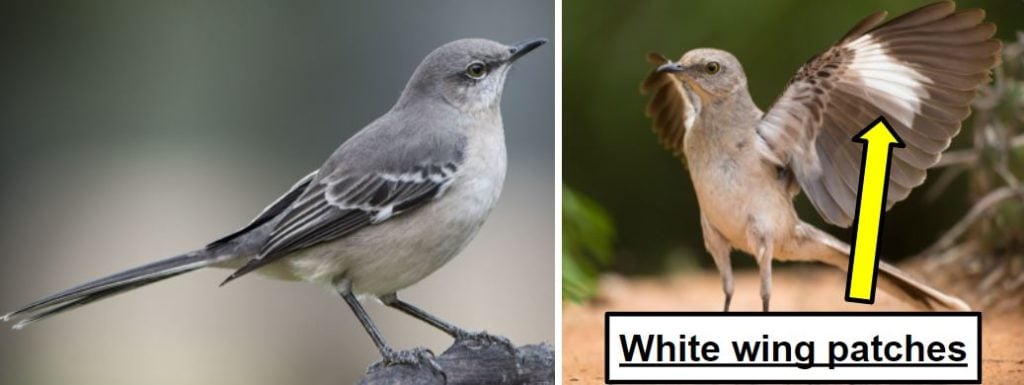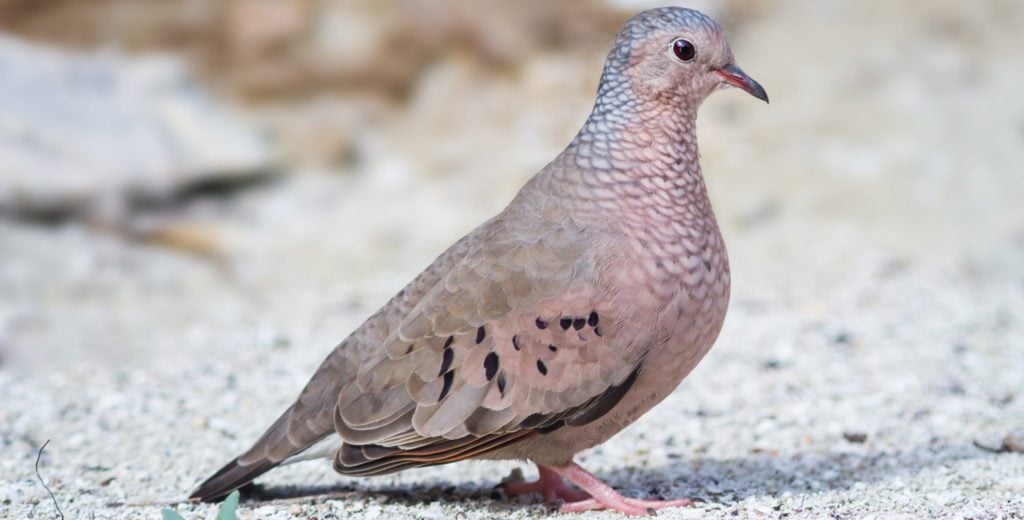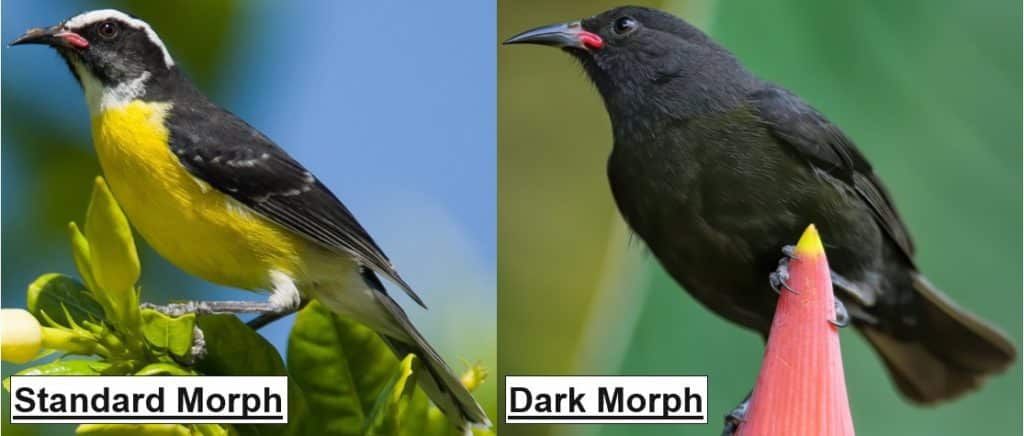9 Types of BIRDS Found on the Cayman Islands! (COMMON)
Below you will find 9 COMMON BIRDS that live in the Cayman Islands!

Believe it or not, over 200 species have been observed here, including many birds that only visit during migration. Because of the incredible variety, it would be impossible to list EVERY single type below.
So I did my best to come up with a list of the birds that are seen the MOST. Enjoy! 🙂
Common Birds of the Cayman Islands:
#1. Ruddy Turnstone
- Arenaria interpres

Identifying Characteristics:
- Breeding males have a chestnut and black pattern on the back, similar to a calico cat.
- They have orange legs, which are brighter during the breeding season.
Ruddy Turnstones occupy different habitats each season. They nest along rocky coasts in the Arctic during the breeding season. While migrating, they visit plowed fields and shorelines of lakes. Finally, they congregate on rocky shorelines and beaches in the winter.
These beautiful shorebirds have a unique feeding style that earned them their name. They insert their bills under stones, shells, and other objects, flipping them over to find food underneath. Several Ruddy Turnstones may work together to flip a large object.
They will also probe under seaweed and other debris. Their low center of gravity and special feet with short, sharply curved toenails allow them to walk easily on wet and slippery rocks. WATCH BELOW!

#2. Green Heron
- Butorides virescens

Identifying Characteristics:
- Small heron with a long, dagger-like bill.
- Their back is gray-green. Head and neck are chestnut-brown, except for the green-black cap on the head.
- The neck is commonly drawn into their body.
This small heron is found in the Cayman Islands in any wet habitat that includes lots of vegetation, which provides places for them to stay hidden. You will most often see them foraging at dawn or dusk, as they prefer to stay out of sight during most of the day.

Green Herons are ambush predators and mainly eat fish, waiting patiently for a small one to swim by so they can snap it up with their long bill. Interestingly, these birds actually use tools to help them hunt! They will drop insects, feathers, or other items into the water, which entice small fish to come closer to investigate.
The first time I heard the “skeow” call of an alarmed Green Heron, I had no idea what I heard because it was so unique. But luckily, these sounds are easy to learn, and now I can easily identify these herons when I’m visiting most wetlands.
#3. Northern Mockingbird
- Mimus polyglottos

Identifying Characteristics:
- Medium-sized grey songbird with a LONG, slender tail.
- Distinctive white wing patches that are visible when in flight.
These birds are hard to miss in the Cayman Islands!
First, Northern Mockingbirds LOVE to sing, and they almost never stop. Sometimes they will even sing through the entire night. If this happens to you, it’s advised to keep your windows closed if you want to get any sleep. 🙂
In addition, Northern Mockingbirds have bold personalities. For example, they commonly harass other birds by flying slowly around them and then approaching with their wings up, showing off their white wing patches.
#4. Common Ground Dove
- Columbina passerina

Identifying Characteristics:
- These doves are small, being only slightly larger than a sparrow!
- They have a plain grey-brown back. The underparts have a pinkish tint to them.
- Small heads with a scaled pattern on their breast and neck. Dark spots on the wings.
Common Ground Doves are typically easy to find in the Cayman Islands. Look for them feeding on the ground beneath bird feeders, cleaning up the grains and other seeds that fall from above.
These doves primarily nest on the ground! Simple nests are built lined with a few types of grass, weeds, and other plant matter. Being on the ground, they can make an easy meal for many predators. Their primary defense is to blend into their surroundings and thick vegetation.
Common Ground Doves are relatively vocal. They can be heard at all times of the day and at any time of the year. Listen for a repeated, soft, high-pitched coo with a rising inflection.
#5. Bananaquit
- Coereba flaveola

Identifying Characteristics:
- Adults range from 10-13 cm (4-5 in) long.
- Most adults have dark gray upperparts, a black crown, and a yellow chest, belly, and rump.
Bananaquits have something in common with many humans I know – a sweet tooth! Also known as “sugar birds” in the Cayman Islands, this species is attracted to nectar feeders and bowls of sugar. They even enter homes looking for sweet treats.
Bananaquits are small, colorful, and known for adapting easily to human habitats. They like fruit and nectar, so they spend a lot of time near humans near flower gardens or fruit trees.
This species’ reliance on humans doesn’t stop with their diet. They often build their nests on human-made objects, including lampposts and garden trellises. Look for a globe-shaped tangle of sticks and leaves between 5 and 30 feet (1.5 to 9 m) off the ground.
#6. Magnificent Frigatebird
- Fregata magnificens

Identifying Characteristics:
- Long, narrow wings with a deeply forked tail.
- Males have a red throat patch, which is easily seen during the breeding season.
- Females have a white breast patch.
As the name implies, seeing these seabirds soaring effortlessly in the sky is quite “magnificent.” Using their forked tails to steer, they barely have to flap to stay afloat in the sky.
Due to the fact that their feathers are not waterproof like other seabirds, Magnificent Frigatebirds rarely land in the water and spend almost their entire lives flying. For food, they commonly steal fish from other birds or harass them until they regurgitate their meal, which they grab in midair! Their pirating ways have earned frigatebirds the nickname the “man-o-war bird.”
With Magnificent Frigatebirds, the “early bird” does not get the worm! Most individuals don’t take flight until later in the afternoon when thermals and winds are at their greatest. 🙂
#7. Zenaida Dove
- Zenaida aurita

Identifying Characteristics:
- Approximately 28–30 cm (11–12 in) in length.
- While flying, look for white plumage on the inner part of the wing.
Zenaida Doves look VERY similar to Mourning Doves and inhabit the same ecological niches. The main difference is that Zenaida Doves are smaller overall, slightly darker in color, and have a shorter, more rounded tail. Look for these birds in the Cayman Islands in open, coastal habitats on the ground, feeding on seeds and grains.
A Zenaida Doves mournful song also sounds similar to a Mourning Dove but is faster in pace. You can listen below!
#8. Royal Tern
- Thalasseus maximus

Identifying Characteristics:
- Adults range from 45-50 cm (17.7-19.7 in) in length and have a 100-110 cm (39.4-43.3 in) wingspan.
- Breeding adults are gray below and white above.
- They have a black crest and a bright orange bill.
Royal Terns spend their lives in warm coastal waters. They’re frequently spotted in sheltered areas with shallow water, such as estuaries, bays, lagoons, and sandy beaches. They occasionally travel out to sea or inland, especially when feeding young, but stay within 80 km (50 mi) of the coast.
Breeding pairs of Royal Terns choose a site and build their nests together. The nests are simple scrapes in the earth. But, they have an unusual way of strengthening their nests. They defecate around the rim of the nest, and as it hardens, it reinforces the nest rim and helps keep it from flooding.
#9. Greater Antillean Grackle
- Quiscalus niger

Identifying Characteristics:
- Males are glossy black with a tail that resembles a rudder.
- Females are black as well but less glossy. Smaller tails than males.
- Yellow eyes.
Greater Antillean Grackles are often found near people in the Cayman Islands, hanging around hoping to receive leftover food! These bold birds can become surprisingly tame, even going into restaurants.
Just like other grackles, this species is highly gregarious. You will most likely never see a Greater Antillean Grackle alone.
Which of these birds have you seen before in the Cayman Islands?
Leave a COMMENT below! 🙂
Learn more about other creatures in the Cayman Islands:

